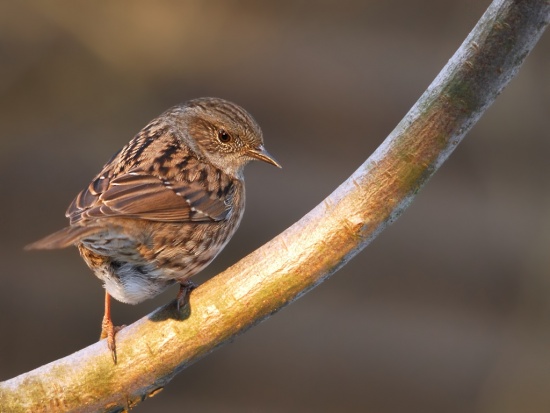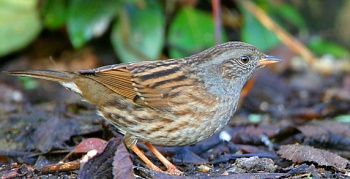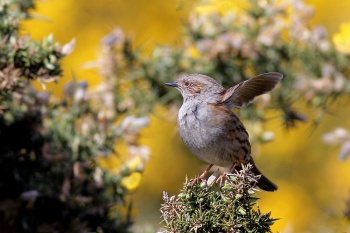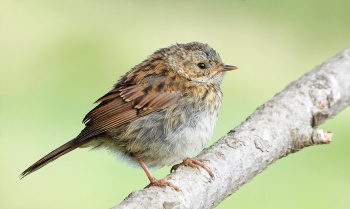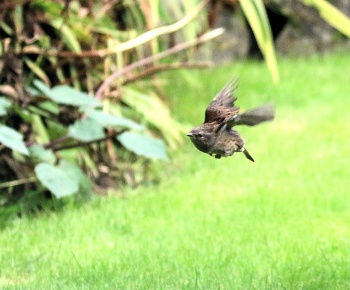(→External Links: Repaired typos!) |
(References updated) |
||
| Line 54: | Line 54: | ||
====Vocalisation==== | ====Vocalisation==== | ||
Loud penetrating Tseep. Song high pitched fast warble.<br /> | Loud penetrating Tseep. Song high pitched fast warble.<br /> | ||
| + | <br /> | ||
{{ Audio|Prunella modularis (song).mp3 }} | {{ Audio|Prunella modularis (song).mp3 }} | ||
| − | |||
==References== | ==References== | ||
| − | #{{Ref- | + | #{{Ref-Clements6thOct22}}#BF Member observations |
#Davies, N. B. (1983). Polyandry, cloaca-pecking and sperm competition in dunnocks. Nature. 302 (5906): 334–336. doi:10.1038/302334a0. | #Davies, N. B. (1983). Polyandry, cloaca-pecking and sperm competition in dunnocks. Nature. 302 (5906): 334–336. doi:10.1038/302334a0. | ||
{{ref}} | {{ref}} | ||
Latest revision as of 10:27, 8 April 2023
Alternative name: Hedge Accentor, Hedge Sparrow
- Prunella modularis
Identification
L. 13-14.5 cm (5-5¾ in)
- Black and brown streaks on back
- Streaked brown cap
- Grey throat
- Brown eye
- Fine dark bill
Identification Hints
One of the things to look for is the fine, insect-eating bill which immediately separates it from a sparrow. (In the past the species was often called 'hedge sparrow'.) The grey neckband is also a good field mark, which immediately rules out any warbler (which its song might mistakenly suggest). It also lacks the pale supercilium which many warblers exhibit.
Distribution
From the British Isles to central Europe and from the Balkans to the Caucasus birds are mainly resident or undergo only short-distance dispersal. Further east and north populations are more strongly migratory and the winter range extends from southern Spain to Turkey and the Middle East and on many Mediterranean islands. Scarce or rare winter visitor to parts of North Africa.
Vagrants recorded north to Svalbard, Bear Island, Iceland and the Faroes, and in the south as far as the Canary Islands, Mauritania, Algeria, Libya and Kuwait.
Seen in the UK all year. Found in North and Eastern Europe only in summer.
Taxonomy
Subspecies
There are 8 subspecies[1]:
- P. m. hebridium: are darker than occidentalis with rufous-brown plumage on wings.
- Ireland, Outer Hebrides, Inner Hebrides and western Scotland
- P. m. occidentalis: are darker than birds from mainland Europe, especially on head and neck but also below
- P. m. modularis:
- P. m. mabbotti:
- South-western France to Pyrénées, Iberian Peninsula and Apennine Mountains
- P. m. meinertzhageni:
- Southern Yugoslavia and Bulgaria
- P. m. fuscata:
- Mountains of Crimean Peninsula
- P. m. euxina: has paler streaking and paler grey crown than nominate
- Northern Turkey to western Caucasus Mountains
- P. m. obscura: much paler and duller than other races with whitish mottling on breast
Habitat
Found in woodland and scrub, city parks and gardens, in hedgerows and copses on farmland. In mountains and the north occurs in pine, larch and spruce forests, and in willow, birch and alder scrub.
Breeds in parks, gardens, open woodland, heaths and commons with gorse or scrub, areas with hedges and thick shrubbery, also young conifer stands; but in northern Europe mainly in dense spruce plantations, also in juniper country and upland forest.
Behaviour
Resident; migratory in north. Rather shy and retiring in summer.
It is a rather unobtrusive bird, sometimes hopping around flowerbeds or at the base of bushes but it is not particularly shy and you quite often see it on patios or roadsides.
Breeding
Nests in thick bush or low down in conifer. The nest is a small grassy cup, lined with hair, moss, feathers, and wool. There may be 2 or 3 broods. This species is known to have a polyandrous breeding system in which males outnumber females, and females mate with multiple males leading to sperm competition. [3]
Diet
Forages on the ground, often close to cover, picks up seeds and small insects.
Vocalisation
Loud penetrating Tseep. Song high pitched fast warble.
References
- Clements, J. F., T. S. Schulenberg, M. J. Iliff, T. A. Fredericks, J. A. Gerbracht, D. Lepage, S. M. Billerman, B. L. Sullivan, and C. L. Wood. 2022. The eBird/Clements checklist of Birds of the World: v2022. Downloaded from https://www.birds.cornell.edu/clementschecklist/download/
- BF Member observations
- Davies, N. B. (1983). Polyandry, cloaca-pecking and sperm competition in dunnocks. Nature. 302 (5906): 334–336. doi:10.1038/302334a0.
Recommended Citation
- BirdForum Opus contributors. (2025) Dunnock. In: BirdForum, the forum for wild birds and birding. Retrieved 19 April 2025 from https://www.birdforum.net/opus/Dunnock
External Links
GSearch checked for 2020 platform.1




